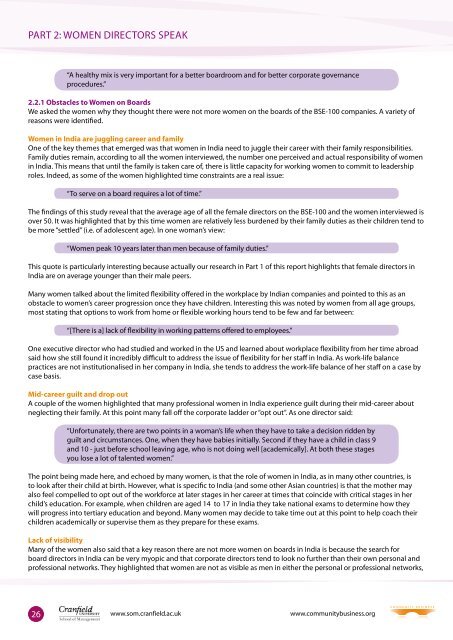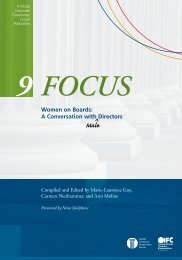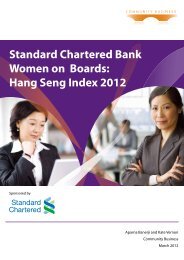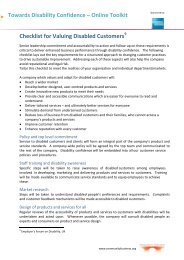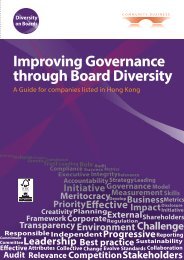Standard Chartered Bank: Women on Corporate Boards in India 2010
Standard Chartered Bank: Women on Corporate Boards in India 2010
Standard Chartered Bank: Women on Corporate Boards in India 2010
Create successful ePaper yourself
Turn your PDF publications into a flip-book with our unique Google optimized e-Paper software.
PART 2: WOMEN DIRECTORS SPEAK<br />
“A healthy mix is very important for a better boardroom and for better corporate governance<br />
procedures.”<br />
2.2.1 Obstacles to <str<strong>on</strong>g>Women</str<strong>on</strong>g> <strong>on</strong> <strong>Boards</strong><br />
We asked the women why they thought there were not more women <strong>on</strong> the boards of the BSE-100 companies. A variety of<br />
reas<strong>on</strong>s were identified.<br />
<str<strong>on</strong>g>Women</str<strong>on</strong>g> <strong>in</strong> <strong>India</strong> are juggl<strong>in</strong>g career and family<br />
One of the key themes that emerged was that women <strong>in</strong> <strong>India</strong> need to juggle their career with their family resp<strong>on</strong>sibilities.<br />
Family duties rema<strong>in</strong>, accord<strong>in</strong>g to all the women <strong>in</strong>terviewed, the number <strong>on</strong>e perceived and actual resp<strong>on</strong>sibility of women<br />
<strong>in</strong> <strong>India</strong>. This means that until the family is taken care of, there is little capacity for work<strong>in</strong>g women to commit to leadership<br />
roles. Indeed, as some of the women highlighted time c<strong>on</strong>stra<strong>in</strong>ts are a real issue:<br />
“To serve <strong>on</strong> a board requires a lot of time.”<br />
The f<strong>in</strong>d<strong>in</strong>gs of this study reveal that the average age of all the female directors <strong>on</strong> the BSE-100 and the women <strong>in</strong>terviewed is<br />
over 50. It was highlighted that by this time women are relatively less burdened by their family duties as their children tend to<br />
be more “settled” (i.e. of adolescent age). In <strong>on</strong>e woman’s view:<br />
“<str<strong>on</strong>g>Women</str<strong>on</strong>g> peak 10 years later than men because of family duties.”<br />
This quote is particularly <strong>in</strong>terest<strong>in</strong>g because actually our research <strong>in</strong> Part 1 of this report highlights that female directors <strong>in</strong><br />
<strong>India</strong> are <strong>on</strong> average younger than their male peers.<br />
Many women talked about the limited flexibility offered <strong>in</strong> the workplace by <strong>India</strong>n companies and po<strong>in</strong>ted to this as an<br />
obstacle to women’s career progressi<strong>on</strong> <strong>on</strong>ce they have children. Interest<strong>in</strong>g this was noted by women from all age groups,<br />
most stat<strong>in</strong>g that opti<strong>on</strong>s to work from home or flexible work<strong>in</strong>g hours tend to be few and far between:<br />
“[There is a] lack of flexibility <strong>in</strong> work<strong>in</strong>g patterns offered to employees.”<br />
One executive director who had studied and worked <strong>in</strong> the US and learned about workplace flexibility from her time abroad<br />
said how she still found it <strong>in</strong>credibly difficult to address the issue of flexibility for her staff <strong>in</strong> <strong>India</strong>. As work-life balance<br />
practices are not <strong>in</strong>stituti<strong>on</strong>alised <strong>in</strong> her company <strong>in</strong> <strong>India</strong>, she tends to address the work-life balance of her staff <strong>on</strong> a case by<br />
case basis.<br />
Mid-career guilt and drop out<br />
A couple of the women highlighted that many professi<strong>on</strong>al women <strong>in</strong> <strong>India</strong> experience guilt dur<strong>in</strong>g their mid-career about<br />
neglect<strong>in</strong>g their family. At this po<strong>in</strong>t many fall off the corporate ladder or “opt out”. As <strong>on</strong>e director said:<br />
“Unfortunately, there are two po<strong>in</strong>ts <strong>in</strong> a woman’s life when they have to take a decisi<strong>on</strong> ridden by<br />
guilt and circumstances. One, when they have babies <strong>in</strong>itially. Sec<strong>on</strong>d if they have a child <strong>in</strong> class 9<br />
and 10 - just before school leav<strong>in</strong>g age, who is not do<strong>in</strong>g well [academically]. At both these stages<br />
you lose a lot of talented women.”<br />
The po<strong>in</strong>t be<strong>in</strong>g made here, and echoed by many women, is that the role of women <strong>in</strong> <strong>India</strong>, as <strong>in</strong> many other countries, is<br />
to look after their child at birth. However, what is specific to <strong>India</strong> (and some other Asian countries) is that the mother may<br />
also feel compelled to opt out of the workforce at later stages <strong>in</strong> her career at times that co<strong>in</strong>cide with critical stages <strong>in</strong> her<br />
child’s educati<strong>on</strong>. For example, when children are aged 14 to 17 <strong>in</strong> <strong>India</strong> they take nati<strong>on</strong>al exams to determ<strong>in</strong>e how they<br />
will progress <strong>in</strong>to tertiary educati<strong>on</strong> and bey<strong>on</strong>d. Many women may decide to take time out at this po<strong>in</strong>t to help coach their<br />
children academically or supervise them as they prepare for these exams.<br />
Lack of visibility<br />
Many of the women also said that a key reas<strong>on</strong> there are not more women <strong>on</strong> boards <strong>in</strong> <strong>India</strong> is because the search for<br />
board directors <strong>in</strong> <strong>India</strong> can be very myopic and that corporate directors tend to look no further than their own pers<strong>on</strong>al and<br />
professi<strong>on</strong>al networks. They highlighted that women are not as visible as men <strong>in</strong> either the pers<strong>on</strong>al or professi<strong>on</strong>al networks,<br />
26<br />
www.som.cranfield.ac.uk<br />
www.communitybus<strong>in</strong>ess.org


